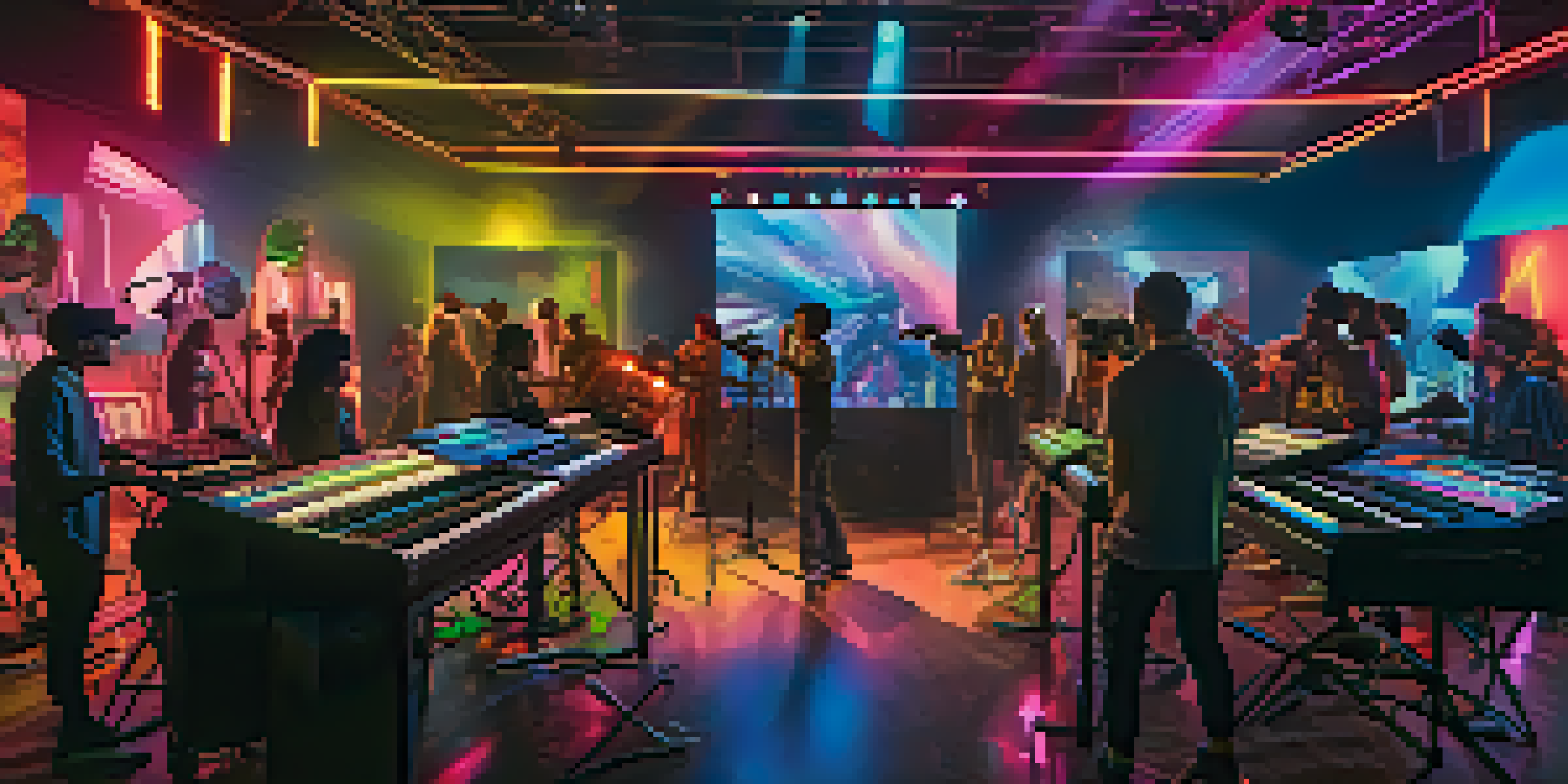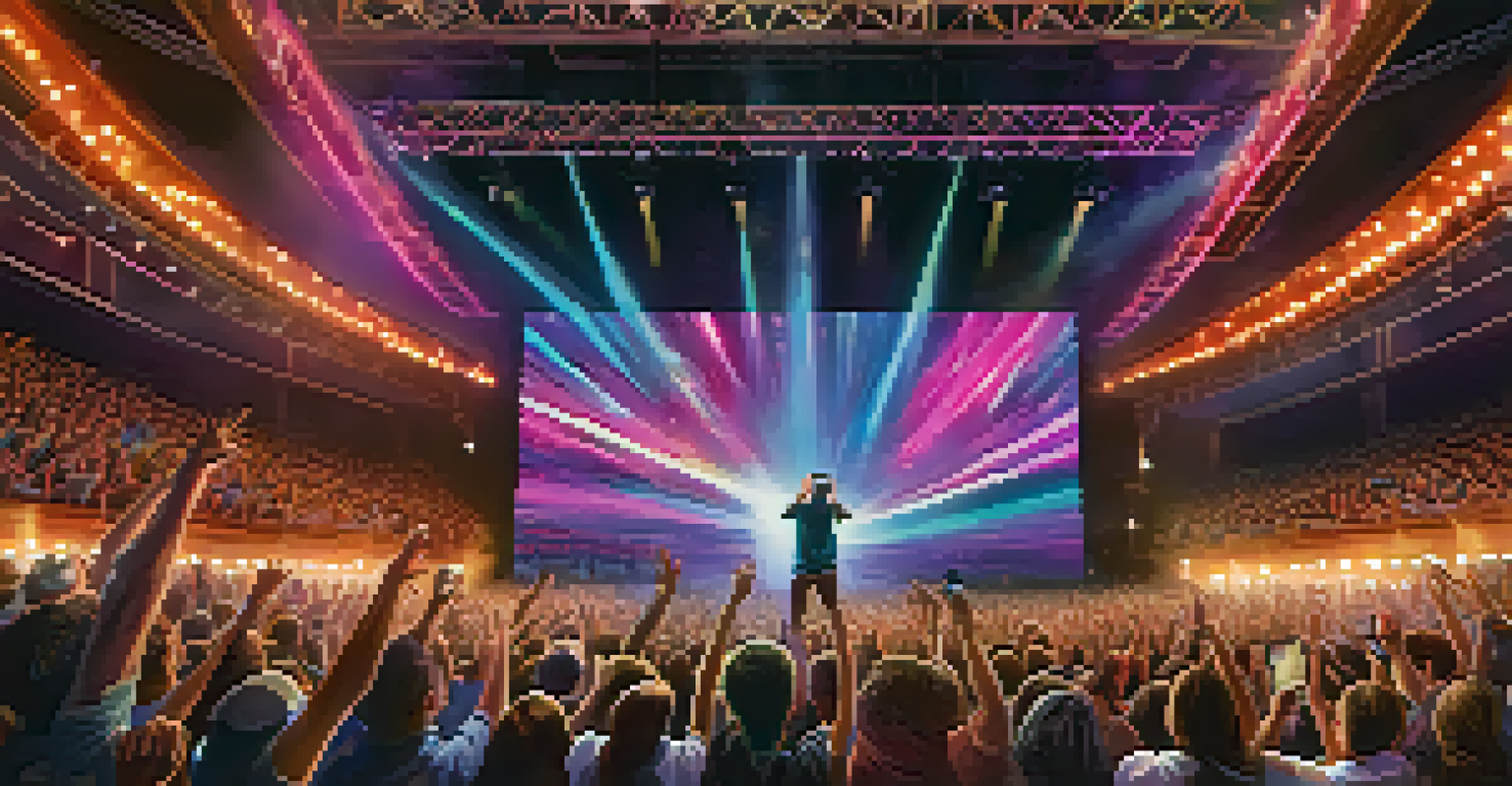The Evolution of Music Videos in the Digital Age

The Birth of Music Videos: A Brief History
Music videos have come a long way since their inception in the 1980s. Initially, they served as promotional tools for songs, with artists like Michael Jackson setting the standard through innovative visuals. These early videos were often a unique blend of storytelling and performance, captivating audiences and paving the way for future formats.
Music videos are the new short stories of our time, capturing emotions and narratives in just a few minutes.
As MTV launched in 1981, it brought music videos into the mainstream, creating a cultural phenomenon. Suddenly, artists weren't just selling music; they were selling an entire visual experience. This shift marked the beginning of a new era where visuals became as essential as the music itself.
The 1990s and 2000s saw an explosion of creativity, with directors like David LaChapelle and Spike Jonze pushing the boundaries of what music videos could be. The combination of artistic vision and powerful music led to iconic moments that are still celebrated today.
The Rise of the Internet and the Impact on Music Videos
With the advent of the internet in the late 1990s, music videos began to reach audiences in unprecedented ways. Platforms like YouTube, launched in 2005, changed the game, allowing anyone with an internet connection to access a vast library of videos. This democratization of content meant that emerging artists could now showcase their work alongside established stars.

The ability to share content easily online also meant that music videos could go viral almost instantly. A single catchy video could generate millions of views in just days, creating a new breed of celebrity. This shift forced artists to be more creative in their approach, as they sought to capture the attention of an ever-discerning audience.
Music Videos Evolved with Technology
Advancements in production tools have significantly enhanced the quality and creativity of music videos, enabling artists to explore new visual storytelling techniques.
Moreover, this new landscape allowed for immediate feedback. Artists could gauge audience reactions through comments and shares, which in turn influenced the direction of their future projects. The interplay between artists and fans became more dynamic, fostering a sense of community around music.
Technological Advancements and Their Role
As technology evolved, so did the production quality of music videos. From high-definition cameras to sophisticated CGI, the tools available to creators have expanded dramatically. These advancements have led to more visually stunning productions that push the limits of imagination.
The power of music videos lies in their ability to blend artistry with storytelling, creating a visual experience that resonates deeply with audiences.
For instance, the use of drones has transformed how artists capture footage, allowing for breathtaking aerial shots that were once impossible. Additionally, editing software has become more accessible, enabling even indie artists to produce high-quality videos without a massive budget. This accessibility has leveled the playing field in the music industry.
Moreover, virtual reality (VR) and augmented reality (AR) are now beginning to play a role in music videos, offering immersive experiences that engage fans in new ways. As these technologies continue to mature, the potential for innovative storytelling in music videos is limitless.
The Role of Social Media in Music Video Promotion
Social media platforms have become essential for promoting music videos in the digital age. Artists now leverage platforms like Instagram, TikTok, and Twitter to build anticipation and engage with fans before a video release. This pre-release strategy can create a buzz that translates into higher view counts once the video drops.
TikTok, in particular, has reshaped how music is consumed and promoted. Many songs gain popularity through viral challenges, often stemming from their corresponding music videos. This phenomenon has not only boosted song sales but has also led to a surge in creativity among users who create their own content around these music videos.
Social Media Transformed Promotion
Platforms like TikTok and Instagram have reshaped how music videos are promoted, allowing artists to build excitement and engage fans before releases.
The interactive nature of social media allows fans to participate in the music video experience actively. From sharing their favorite clips to creating fan edits, the audience becomes a part of the narrative, fostering a deeper connection between the artist and their fans.
The Shift Towards Shorter Content Formats
In a world where attention spans seem to dwindle, music videos are also adapting by becoming shorter. The rise of platforms like TikTok has popularized the concept of short-form video content, leading artists to create clips that are often under a minute long. This shift reflects the need to capture audiences quickly and efficiently.
These shorter formats encourage artists to focus on impactful visuals and catchy hooks, ensuring that they can make a lasting impression in less time. This trend has not only influenced music videos but has also permeated other forms of media, pushing creators to be more concise and engaging.
As a result, many artists are now experimenting with formats that combine traditional music videos with quick, snappy content. This hybrid approach keeps viewers engaged while still delivering the essence of the song, showcasing the adaptability of the music video medium.
The Globalization of Music Videos
The digital age has also facilitated the globalization of music videos, allowing artists from different cultures to reach international audiences. Platforms like YouTube and Spotify have made it easier for fans to discover music from around the world, breaking down geographical barriers. This has led to the rise of genres like K-pop, which now boasts a massive global following.
As diverse musical influences blend together, we see exciting collaborations between artists from different backgrounds. These cross-cultural partnerships often result in music videos that showcase a rich tapestry of styles and visuals, captivating audiences worldwide. The fusion of cultures in music videos not only reflects the current global landscape but also enriches the art form itself.
Globalization of Music Videos
The digital age has broken geographical barriers, allowing diverse artists to reach international audiences and collaborate, resulting in a richer musical landscape.
Furthermore, the accessibility of music videos has empowered independent artists to share their unique stories and sounds. This democratization of content allows for a wider range of voices to be heard, contributing to a more inclusive music industry.
The Future of Music Videos: Trends to Watch
Looking ahead, several trends are poised to shape the future of music videos. One of the most exciting is the potential for interactive videos, where viewers can choose different storylines or endings. This immersive experience can deepen fan engagement, creating a sense of ownership over the content.
Another trend to watch is the continued integration of artificial intelligence (AI) in video production. AI tools can help streamline the creative process, providing valuable insights into audience preferences and optimizing content for maximum impact. This technology could revolutionize how artists approach their music videos.

As live streaming becomes more prevalent, artists may also explore ways to incorporate real-time interactions into their music videos. Imagine a live performance where viewers can influence the visuals or even the setlist. The possibilities are endless, and the future of music videos is undoubtedly bright.